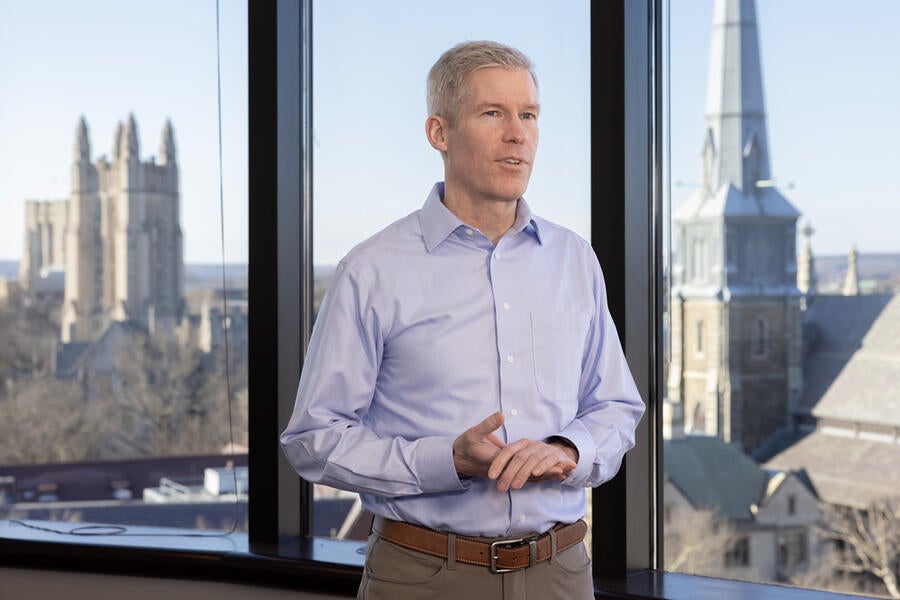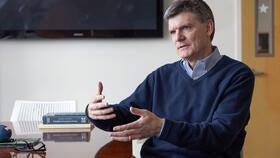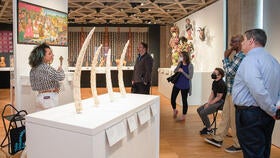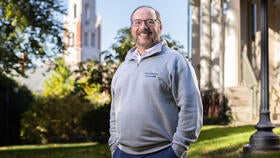
John Whelan, vice president for human resources (HR), oversees a talented team of HR professionals who support all aspects of the staff employment life cycle at Yale. He champions an inclusive, diverse, and supportive work environment. We sat down with him to discuss the initiatives driving the work of HR. The conversation has been edited and condensed.
How do you view the work of Human Resources within the university’s operations strategy?
In July 2022, the operations leadership team, under Jack Callahan Jr., senior vice president for operations, launched a multi-year operations strategy supporting the university’s mission.
We also agreed on three multi-year initiatives to support the strategy: OneFinance, Recruiting, and Learning. Two of those three strategic initiatives are closely associated with HR and aligned strongly with HR’s strategic plan called AdvanceHR. We established AdvanceHR by gaining a broad understanding of what the university and all of the schools and units within Yale need from HR to successfully achieve their goals and priorities.
We talked to many collaborators and reviewed the university’s mission statement as well as the goals and mission statements of various departments. Using that data, we developed HR’s three priorities, which are driven by the needs of the university: attracting and retaining a talented and diverse workforce, enhancing the HR user experience, and building a collaborative HR team.
Can you talk about the goals of the Learning Strategic Initiative (LSI) and the Recruiting Strategic Initiative (RSI) and the progress your team has made so far?
The staff dedicated to these projects has done a lot of hard work in the past two years and has made significant progress. In January 2024, we launched LSI, which included the rollout of Workday Learning and the new Learn and Grow website. This site highlights tools and resources for staff and their managers to understand how to incorporate learning into their jobs and their employees’ jobs.
For RSI, one area we focus heavily on is proactive sourcing, or looking for candidates before positions become available and not waiting until the job is posted. That is going to be a big game-changer. We are also focusing on diversity and aligning our efforts directly with the Belonging at Yale initiative. We are doing as much as we can to have deeply talented and diverse candidate pools.
Lastly, we are exploring a technology upgrade that would potentially replace STARS, our current applicant tracking system. This upgrade would be a significant enhancement for staff recruiting. We have had a lot of positive feedback from people around the university, and the time is right to do this.
What is the job framework redesign (JFR)?
JFR is focused on how we organize staff positions within a structure that makes it easier for staff to see how their jobs relate to other jobs at Yale. The goal is to create a more transparent and straightforward way for staff to chart their career paths.
It is hard to look across the university and know what skills are required or what the different levels mean. This redesign is going to clarify all of that. With this new approach, staff will be able to see what skills or competencies are required for other jobs and, if necessary, plan ahead and consider pursuing some professional development. This will directly tie into the LSI and RSI because it will be part of how people can apply for other jobs and grow their skills and careers. These three initiatives have a tremendous amount of intersection with each other.
What’s your focus for HR over the next five years?
We have three priority areas in AdvanceHR. Over the next five years we want to:
- Focus on attracting and retaining a talented and diverse workforce. Retain talented people and reduce vacancies.
- Enhance the HR user experience and all the different ways people interact with HR. This includes online forms, getting simple questions answered, strategizing and planning for workforce reorganizations, and everything in between. We want to ensure that all HR interactions are helpful, easy, efficient, intuitive, and pleasant.
- OneHR is strictly internally focused, with three subsets aimed at building a collaborative HR team. We want to ensure we have a trusting, psychologically safe work environment where people feel safe bringing their whole selves to work. We want to ensure everyone understands, within our HR delivery model, how their role relates to everyone else’s role. We want to operate as one team and eliminate redundant work or gaps. Lastly, we want to provide professional development for everyone in HR through webinars, conferences, conversations, suggested readings, and more.
How did the pandemic change HR’s practices?
Two areas that jump out are focusing on employee well-being with an emphasis on mental health and navigating the hybrid work schedule. We saw a lot of strain and stress that came out due to the pandemic that, to some extent, still lingers. We’ve done a lot to address this, including looking at how healthcare benefits can support this and trying to encourage a culture at Yale that supports work-life balance. Through campaigns like “Rest brings out your best,” we aim to help people realize that we must take care of ourselves, including taking PTO and enjoying the holidays. I like to use the phrase, “Don’t fail vacation; it’s part of your job.” It is not sustainable for people to work so hard that they can’t take time off.
Post-pandemic, we continue to figure out how to navigate and maximize the hybrid work world. How do we make sure we balance the right amount of remote work, connection to the physical campus, and in-person interactions with colleagues and coworkers? We continue to refine this as we go. Hybrid work is now a part of the workplace reality, and we should make the most of it.
How do you achieve work and life balance?
It is a constant challenge, but I take it very seriously. I try to keep a fairly regular schedule that includes a good night’s sleep and exercise. Early in my life, I didn’t appreciate the amazing value of a good night’s sleep.
I ran track in high school and college, and after 34 years of not competing, I’ve started participating in local age group competitions, mostly 400-meter and 800-meter races. I got into it through the guidance and prompting of Professor Jeffrey Townsend at the School of Public Health. I’ve competed in two indoor track meets so far. It’s been fun, and I hope to compete for as long as I can. I have three rules, in this order: don’t hurt myself, have fun, and be as competitive as I can.






